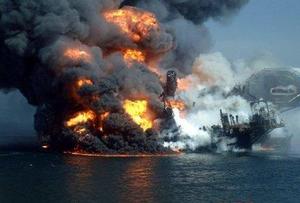Oil spillsScientists: Deepwater Horizon exposed gaps in deepwater oil spill knowledge
On the second anniversary of the Deepwater Horizon oil spill in the Gulf of Mexico, a national team of scientists warns that inadequate knowledge about the effects of deepwater oil well blowouts threatens scientists’ ability to help manage comparable future events

The blazing Deepwater Horizon ablaze in April, 2010 // Source: ppol.gr
On the second anniversary of the Deepwater Horizon oil spill in the Gulf of Mexico, a national team of scientists warns that inadequate knowledge about the effects of deepwater oil well blowouts threatens scientists’ ability to help manage comparable future events.
The findings are reported in a paper published in the May issue of the journal Bioscience. The authors comprise a renowned group of ecotoxicologists, oceanographers, and ecologists — calling themselves the Gulf Oil Spill Ecotoxicology Working Group — who convened under the auspices of the National Science Foundation-supported National Center for Ecological Analysis and Synthesis while the 2010 spill was still active.
A University of California Davis release reports that the article argues that a fundamentally new approach to the study of deepwater spills is needed, particularly because the oil industry is now putting most of its exploration efforts into deep water.
“We really don’t know the effects the Deepwater Horizon spill had in the deep sea because we know little about the ecosystem processes there,” said group co-leader Gary Cherr, director of UC Davis’s Bodega Marine Laboratory. “The deep sea is not a dead zone. It’s not a desert. There’s a lot of life down there. Unfortunately it’s not until a disaster happens that we try to piece together the impacts. That’s difficult to do when you don’t have a complete — or even partial — understanding of the ecosystem” (note that ScienceWatch has ranked UC Davis as the 3rd-ranking U.S. university and seventh in the world for “Top 20 institutions on oil spill citations”).
The Deepwater Horizon oil spill was unlike any other oil spill science and society had encountered.
The well blowout occurred at unprecedented depths and released enormous quantities of oil (an estimated 4.9 billion barrels or 206 million gallons). Marine and wildlife habitats suffered major damage and, the authors assert, continue to suffer today, out of sight. Local economies and livelihoods were hurt, as well.
According to the paper’s authors, the cleanup and containment response to the spill followed a framework that assumed the oil’s behavior would mimic that seen in more familiar shallow-water and surface spills, despite the fact that the dynamics and effects of deepwater oil on ecosystems are not well understood.
The paper represents the first complete conceptual model for understanding both the Deepwater Horizon spill and analogous disasters in the future.
This new model accounts for how a deepwater oil spill unfolds and where the resulting ecological impacts are felt. It also emphasizes that the vast majority of the oil is retained at depth — rapidly emulsified and dispersed due to the physics of the pressurized oil jetting from the wellhead — and, among other response actions, calls into question the overall efficacy of dispersants in that situation.
“We have generally hailed the use of [chemical] dispersants as helpful, but really are basing this on the fact that we seemed to have kept oil from getting to the surface,” said Cherr. “The truth is, much of this oil probably was staying at depth independent of the amount of surfactants we dumped into the ocean. And we dumped a lot of dispersants into the ocean, all told approximately one-third the global supply.”
Co-author Ron Tjeerdema, chair of the UC Davis Department of Environmental Toxicology, concurs. “The problem is we really must address the downside of such compounds, particularly in light of the fact that the upside probably was not so great as it seemed at the time,” he said.
Armed with a new foundation for research and policy implications, the UC Santa Barbara-based NCEAS Gulf Oil Spill Ecotoxicology Working Group is calling for further investigation on the long-term effects of deep-water oil spills like that of the Deepwater Horizon.
“We now have a sense that the bulk of the impact was probably in the mid-water and deep ocean. Who the heck knows what oil does to the mid-water open sea and deep-dwelling critters?” said the study’s lead author, Charles “Pete” Peterson, a professor at University of North Carolina – Chapel Hill. “We need an integrated collaboration between deepwater explorers, modelers, ecotoxicologists, microbial ecologists, and so on, all working together in unprecedented ways. We need a whole new type of marine ecology.”
— Read more in Charles H. Peterson et al., “A Tale of Two Spills: Novel Science and Policy Implications of an Emerging New Oil Spill Model,” BioScience 62, no. 5 (May 2012): 461–69
